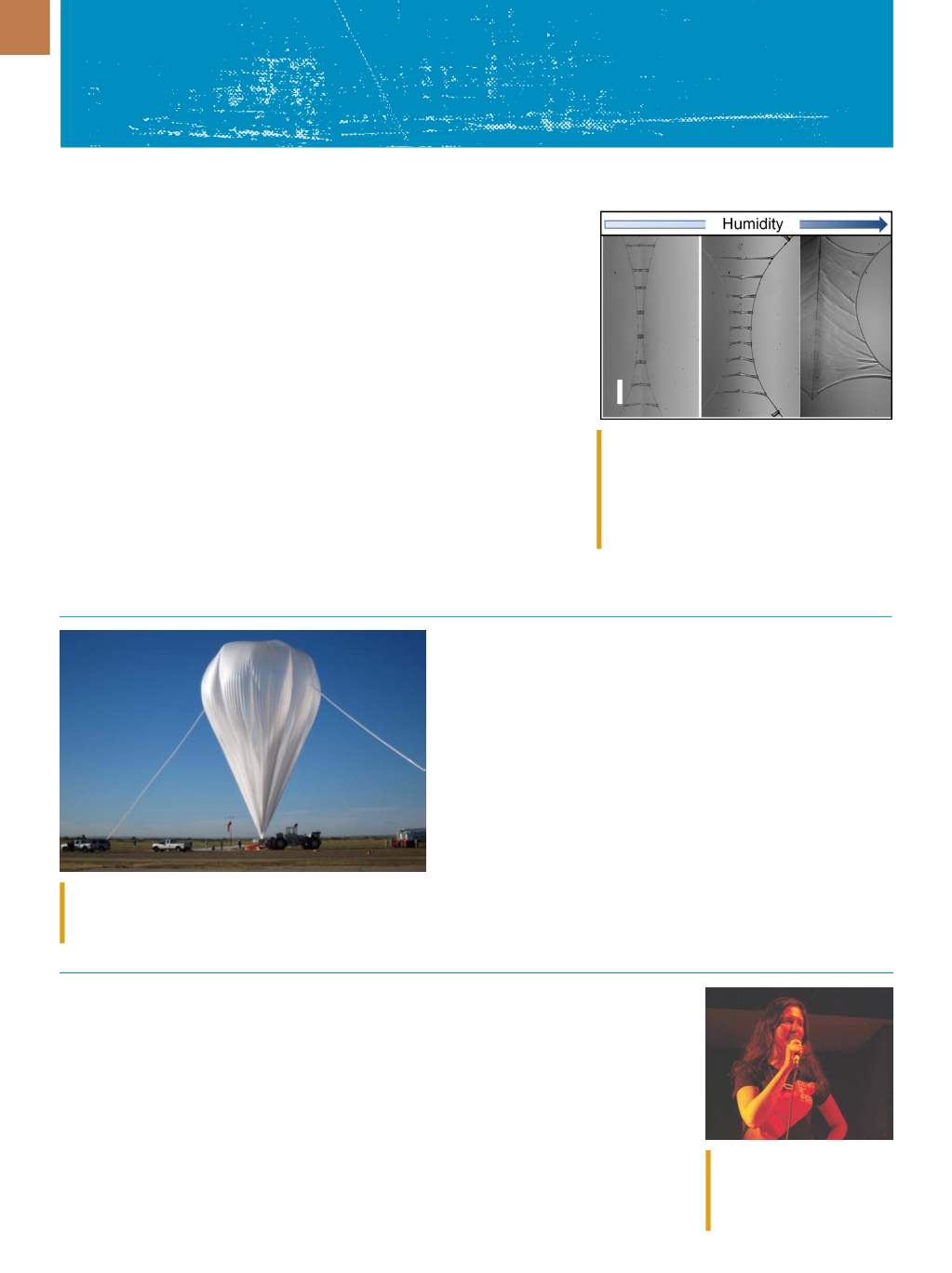

8 0
STRESS RELIEF
A D V A N C E D M A T E R I A L S & P R O C E S S E S | N O V E M B E R / D E C E M B E R 2 0 1 5
SPIDERWEB GLUE SHAPES NEXT GENERATION ADHESIVES
Most spiderwebs are made of spiral-like strands of “capture silk” that play
a key role by retaining prey, freeing spiders to hunt. This special silk consists of
an axial fiber coated with glue droplets at regular intervals. Spider glue is unique
because its adhesion increases in response to humidity, and for some species, ad-
hesion continues to increase up to 100% relative humidity—the exact opposite of
how synthetic adhesives act on human skin in response to higher humidity.
Researchers from the University of Akron, Ohio, and Virginia Polytechnic In-
stitute, Blacksburg, explored the properties underlying the spider glue’s humidity-
responsive adhesion. Scientists measured the adhesion of capture threads from
five different species. “The habitats of these species range from dry to wet and hu-
mid, so we measured the adhesion as a function of humidity and used high-speed
imaging to quantify the spreading rate of the glue droplets,” explains Gaurav Am-
arpuri of Akron. The spreading of a liquid droplet follows the “spreading power
law,” in which low viscosity droplets spread faster than high viscosity droplets. The
group used the spreading power law to calculate glue viscosity as a function of
humidity. “We discovered maximum glue adhesion at the humidity levels at which
the spider usually forages,” says Amarpuri.
uabiomimicry.org.
STAND-UP COMEDYGETSNEWMATERIAL
“I was once asked what kind of music stem cells would like best. Classical, I decided, because
they’re cultured.” This was just one in a string of tales Laura McNamara unraveled at the debut
GlasgowBright Club a fewyears ago, where sciencemeets humor. Bright Club is a comedy-club-style
event featuring scientists and academics, which started at University College London. Academics
brave the spotlight to vent about anything from Greek mythology to neuroscience. Researchers
who perform at Bright Club span all ages, career levels, and disciplines. McNamara, who was cultur-
ing stem cells on nanopatterned titanium surfaces at the time of her first stand-up routine, is now
the science education coordinator at the Glasgow Science Centre.
brightclub.org.
HITCHHIKING TO MARS
Could some of the hardiest bacteria on Earth hitchhike on a
Journey to Mars and survive after landing in a new world? NASA re-
searchers intend to find out. A helium-filled scientific balloon will
soon carry bacteria to the edge of space—Earth’s stratosphere—ex-
posing them to conditions similar to those found on the surface of
Mars. Researchers will measure how long the bacteria can endure,
and will also study the biological underpinnings of bacterial survival
in harsh conditions. A specialized hardware system that will be used
for the study, Exposing Microorganisms in the Stratosphere (E-MIST),
was developed last year at NASA’s Kennedy Space Center in Florida.
towerfts.csbf.nasa.gov.The 2014 test of the E-MIST system is prepared for flight
on August 24 at NASA’s Columbia Scientific Balloon
Facility in Fort Sumner, N.M.
Larinioides cornutus
capture threads peeled
from a glass substrate, under low, medium, and
high humidity conditions. At medium humidity,
glue droplets form a suspension bridge structure
where adhesion is maximum. Scale is 100 µm.
Courtesy of Yizhou Chen/U.Akron.
Researcher Laura McNamara
performs stand-up comedy
about materials for Bright
Club in Scotland.


















